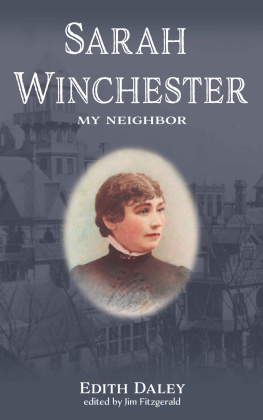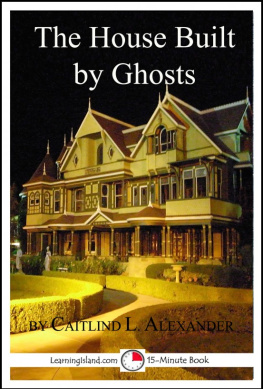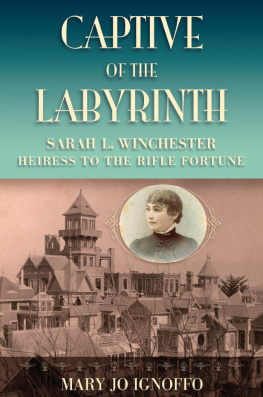Contents
Copyright 2018 by New Forest Books for Jim Fitzgerald. Published by New Forest Books, Concord and Orlando.
All rights, print, digital, and audio, are reserved.
This book is based on 1922 articles written by Edith Daley for two San Jose (CA) newspapers. Those articles have been edited for clarity and to correct typos in the original, printed works.
Mr. Fitzgerald has endeavored to retain the original intent by Ms. Daley, and the authenticity of her memories as a long-time neighbor of Sarah Lockwood Winchester.
Although the author and publisher have made every effort to ensure that the information in this book was correct at press time, the author and publisher do not assume and hereby disclaim any liability to any party for any loss, damage, or disruption caused by errors or omissions, whether such errors or omissions result from negligence, accident, or any other cause.
For more information about this book, or to purchase printed copies for libraries or resale, contact: Winchester@NewForestBooks.com.
Editors Preface
The Winchester Mystery House is among Americas most famous and most haunted houses. It attracts visitors from around the world. Everyone wants to see the curious house built by Sarah Lockwood Winchester.
Did she truly believe she would die if she ever stopped building that gargantuan home in San Jose?
History and the house itself suggest thats true.
Currently, the Winchester house holds about 160 rooms. (The owners keep finding more rooms, hidden behind secret panels and passageways.) But, it was rumored that Mrs. Winchester ordered over 600 rooms, each built according to her plans and those plans may have been given to her in the secret room where she meditated or perhaps communicated with spirits.
Many of those 600 rooms were torn down as soon as they were completed.
The Winchester house included doorways that lead nowhere, or to precipitous drops. Stairs only two inches tall, that weave back and forth like a labyrinth, eventually reaching a height of scarcely three feet. Rooms with no windows. Bathrooms with screen doors, and sometimes no working plumbing.
Was this madness, or something else?
In this book, I present a series of seven articles published in the San Jose News , late in 1922. They were written by librarian, writer, and poet Edith Daley (1874 - 1948), one of Mrs. Winchesters neighbors.
In flowery prose, Ms. Daley describes the house as it was during Mrs. Winchesters life, and how it changed almost immediately upon the owners death.
She also tells the story of a reclusive woman who alternately shunned the outside world, and donated generously to charities.
Balancing local gossip and likely facts, Ms. Daleys story is an interesting one. It tells us more about the mysterious Mrs. Winchester, and what may have driven her to build and build and build, all the way to her death.
I have lightly edited Ms. Daleys articles so they can be better enjoyed by todays readers. As I edited, I tried to retain the poetic style, and stay true to the facts as Ms. Daley presented them. I also tried to repair typesetting mistakes in the original articles; if I missed any, I apologize.
I believe this is an important record written by a contemporary of Mrs. Winchester. It gives us fresh insights and even more mysteries to unravel.
-J.F.
Introduction
The following was the introduction to Edith Daleys series of articles, published almost immediately following the death of Sarah Winchester.
-
The life of Mrs. Sarah L. Winchester, one of the most interesting persons who ever lived in this valley, is to be told for the first time by The News.
Edith Daley has secured a wealth of material about this unique woman, who built the famous old country place on the Winchester road.
In a sympathetic, accurate manner, Edith Daley tells the story of this woman who had a room in her home with walls, carpet, and ceiling of white satin, which no one entered but herself.
She will tell of the seven Japanese servants, employed the year round to do nothing but trim the enormous hedge surrounding the Winchester place.
She will tell why no one was ever admitted to the Winchester place and why Mrs. Winchester annually gave thousands of dollars to various philanthropies.
This serial promises to be one of the most interesting newspaper documents published in years.
Chapter 1
There is something about locked gates set in a towering house-hiding hedge topped with a no admittance sign, flanked by a gold-lettered admonition to beware of the dog, that catches the interest. It arouses one's spirit of democracy to full fledged resentment. It awakens a lively curiosity.
That combination of sensations marked my first, close-up impression of Winchester Place. Or at least all Winchester Place that could be seen by standing on the narrow cement sidewalk outside the grounds. My nose gave an inquisitive and unapologetic nose almost gave an Eskimo salutation to the cold iron of the elaborately grilled iron gate. An entrance gate, that was securely barred. A gate through which no one, unless on business, might enter.
Must Build or Die
The sounds of tapping hammers. The incessant buzz of an energetic saw. The pungent smell of fresh paint.
All three filtered to the newly trimmed and forbidding cypress hedge that balance Winchester Place on the east. Thats where an odd little cement sidewalk runs parallel with the broad highway that now bears the name of Winchester.
Listening to the sounds of carpentry, sniffing the odor of paint, I kept reflecting on a common report: that the rich Mrs. Winchester who lives in this mysterious house with locked gates, believes that when she stops building she will die!
Hearsay. Just gossip of the nearby towns.
But still, there are those who, passing frequently, say that the saws have never stopped buzzing or the hammers quit tapping. And that smell of fresh paint was refreshed daily, as walls and floors were painted and repainted.
In other words: at Winchester Place, building operations are always in progress. Its so constant, the work necessitates a force of carpenters and plumbers and painters hired by the year.
Hole in the Hedge
Snip, snip! I dislike the odor of fresh paint; but this enticed.
Pound, pound, tap, tap. Noise is abhorrent; but these hammers called.
Buzz, Buzz, Buzz! What in the world was it all about? More walls going up or more walls coming down in a smother of plaster and broken lathe that the mistress of Winchester Place might live long and prosper?
Standing there, trying to get a clear view of the tree and shrubbery of skewered house, I shook the locked gates. I shook them until their fancy iron curly-cues rattled.
Pausing, I said to myself: I give a dollar to walk in that garden.
Not that it promised more of blossoms or beauty than any other garden of my intimate acquaintance. Instead, that hedge and those signs triggered an outraged feeling of democracy. I believe in beauty being shared, since God made it all.
And, after mentioning that purely fictitious dollar which I really wouldn't have given to walk in that aristocratically isolated rich woman's garden, I must have inadvertently pulled a bit on the leash of my hand.
Instantly, as if he understood, my dog pulled forward against the leash. He pointed an eager nose at a ragged hole in the tall hedge. Then he whined coaxingly to be allowed to go in an adventure.
For a minute a temptation, aided and abetted by that bit of democratic resentment, tugged at my will as the dog pulled on the leash.
But he was a small dog, and tremendously dear to me. I feared that the beast we were supposed to beware was a huge shaggy creature of fang-tearing ferocity.
Anyway, there was probably a dire penalty for trespassing. Im sure theyd have said so, if I met the lady of the manor or one of her henchmen, and attempted an excuse of a lost dog.













